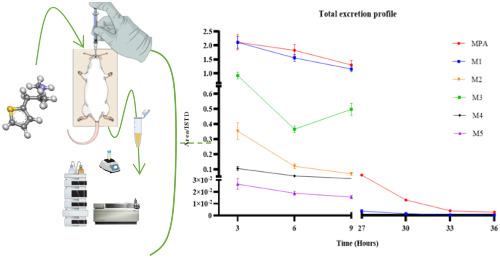当前位置:
X-MOL 学术
›
Drug Test. Anal.
›
论文详情
Our official English website, www.x-mol.net, welcomes your
feedback! (Note: you will need to create a separate account there.)
Urinary excretion profile of methiopropamine in mice following intraperitoneal administration: A liquid chromatography-tandem mass spectrometry investigation.
Drug Testing and Analysis ( IF 2.6 ) Pub Date : 2020-07-17 , DOI: 10.1002/dta.2900 Cristian Camuto 1, 2, 3 , Sheila Pellegrini 1, 2 , Fabio De-Giorgio 3, 4 , Xavier de la Torre 1 , Matteo Marti 5, 6 , Monica Mazzarino 1 , Francesco Botrè 1, 7
Drug Testing and Analysis ( IF 2.6 ) Pub Date : 2020-07-17 , DOI: 10.1002/dta.2900 Cristian Camuto 1, 2, 3 , Sheila Pellegrini 1, 2 , Fabio De-Giorgio 3, 4 , Xavier de la Torre 1 , Matteo Marti 5, 6 , Monica Mazzarino 1 , Francesco Botrè 1, 7
Affiliation

|
We have considered the urinary excretion profile of methiopropamine (MPA), a thiophene ring‐based structural analog of methamphetamine with similar stimulant effects, with the aim of selecting the most appropriate marker(s) of intake that may be useful in forensic analysis. For this purpose, in vitro studies were preliminarily performed on human liver microsomes for tracing the phase I metabolic pathways of MPA, preselecting the best candidates as potential target analytes, and designing the optimal experimental strategy. In vivo studies were then conducted on mice, after the intraperitoneal administration of a 10‐mg/kg dose. Urine samples were collected every 3 h in the first 9 h and, subsequently, from 24 to 36 h, and stored at –80°C until further analysis. The measurements were performed using a targeted procedure based on liquid/liquid extraction followed by liquid chromatography–tandem mass spectrometry analysis. Our results show that in the time interval 0–9 h after administration, MPA was extensively oxidized mainly to nor‐MPA, oxo‐MPA, and two hydroxylated metabolites (ie, hydroxy‐aryl‐methiopropamine and hydroxy‐alkyl‐methiopropamine). All phase I metabolites underwent phase II metabolism, with the formation of nor‐hydroxy‐methiopropamine only in phase II, confirmed by the results obtained after enzymatic hydrolysis with β‐glucuronidase and arylsulfatase. In the time interval 24–36 h after administration, only unchanged MPA and nor‐MPA were detected, suggesting that these two markers are those endowed with the highest diagnostic value. The method was validated for these two principal markers, proving to be fit for anti‐doping, toxicological, and forensic analyses.
中文翻译:

小鼠腹膜内给药后甲硫丙胺的尿液排泄特征:液相色谱-串联质谱研究。
我们考虑了甲硫丙胺 (MPA) 的尿排泄特征,这是一种甲基苯丙胺的基于噻吩环的结构类似物,具有类似的兴奋作用,目的是选择可能用于法医分析的最合适的摄入标志物。为此,初步对人肝微粒体进行了体外研究,以追踪 MPA 的 I 期代谢途径,预选最佳候选物作为潜在的目标分析物,并设计最佳实验策略。体内然后在小鼠腹腔内给予 10 mg/kg 剂量后进行研究。在前 9 小时和随后的 24 至 36 小时内每 3 小时收集一次尿液样本,并将其储存在 –80°C 下直至进一步分析。使用基于液/液萃取的目标程序进行测量,然后进行液相色谱-串联质谱分析。我们的结果表明,在给药后 0-9 小时的时间间隔内,MPA 主要被广泛氧化为nor-MPA、氧代-MPA 和两种羟基化代谢物(即羟基-芳基-甲硫基丙胺和羟基-烷基-甲硫基丙胺)。所有 I 相代谢物都经历了 II 相代谢,仅在 II 相中形成去甲羟基甲硫丙胺,这一点由β酶水解后获得的结果证实葡萄糖醛酸酶和芳基硫酸酯酶。在给药后 24-36 h 的时间间隔内,仅检测到未变化的 MPA 和 Nor-MPA,表明这两个标志物是具有最高诊断价值的标志物。该方法针对这两个主要标志物进行了验证,证明适用于反兴奋剂、毒理学和法医分析。
更新日期:2020-07-17
中文翻译:

小鼠腹膜内给药后甲硫丙胺的尿液排泄特征:液相色谱-串联质谱研究。
我们考虑了甲硫丙胺 (MPA) 的尿排泄特征,这是一种甲基苯丙胺的基于噻吩环的结构类似物,具有类似的兴奋作用,目的是选择可能用于法医分析的最合适的摄入标志物。为此,初步对人肝微粒体进行了体外研究,以追踪 MPA 的 I 期代谢途径,预选最佳候选物作为潜在的目标分析物,并设计最佳实验策略。体内然后在小鼠腹腔内给予 10 mg/kg 剂量后进行研究。在前 9 小时和随后的 24 至 36 小时内每 3 小时收集一次尿液样本,并将其储存在 –80°C 下直至进一步分析。使用基于液/液萃取的目标程序进行测量,然后进行液相色谱-串联质谱分析。我们的结果表明,在给药后 0-9 小时的时间间隔内,MPA 主要被广泛氧化为nor-MPA、氧代-MPA 和两种羟基化代谢物(即羟基-芳基-甲硫基丙胺和羟基-烷基-甲硫基丙胺)。所有 I 相代谢物都经历了 II 相代谢,仅在 II 相中形成去甲羟基甲硫丙胺,这一点由β酶水解后获得的结果证实葡萄糖醛酸酶和芳基硫酸酯酶。在给药后 24-36 h 的时间间隔内,仅检测到未变化的 MPA 和 Nor-MPA,表明这两个标志物是具有最高诊断价值的标志物。该方法针对这两个主要标志物进行了验证,证明适用于反兴奋剂、毒理学和法医分析。











































 京公网安备 11010802027423号
京公网安备 11010802027423号